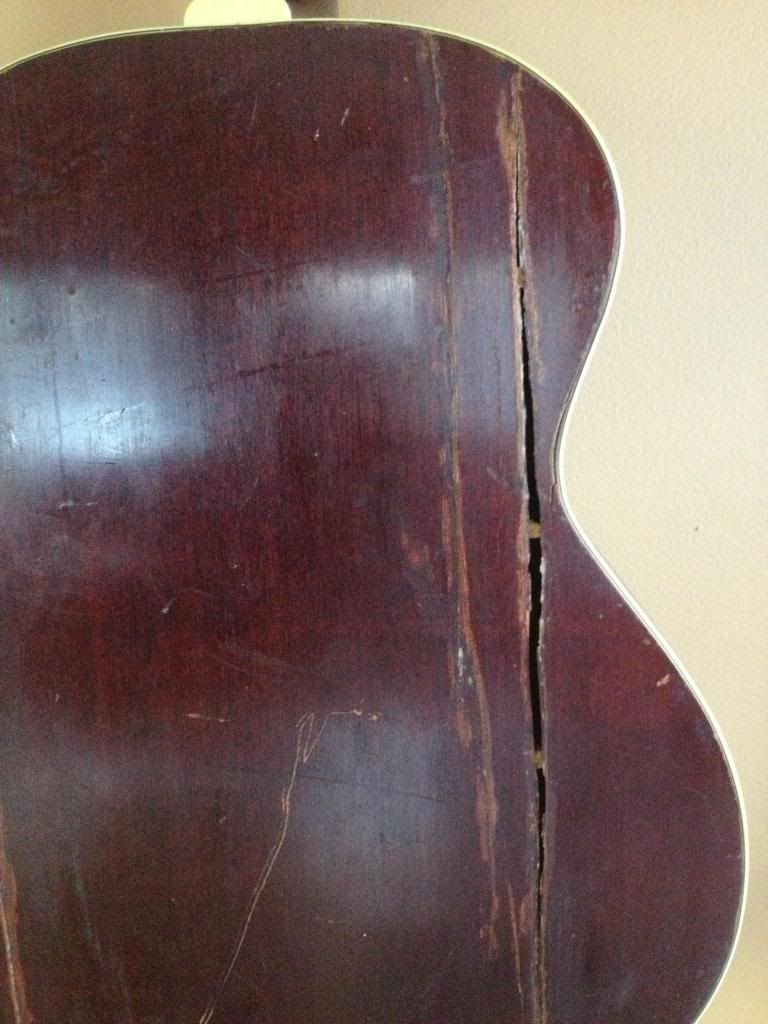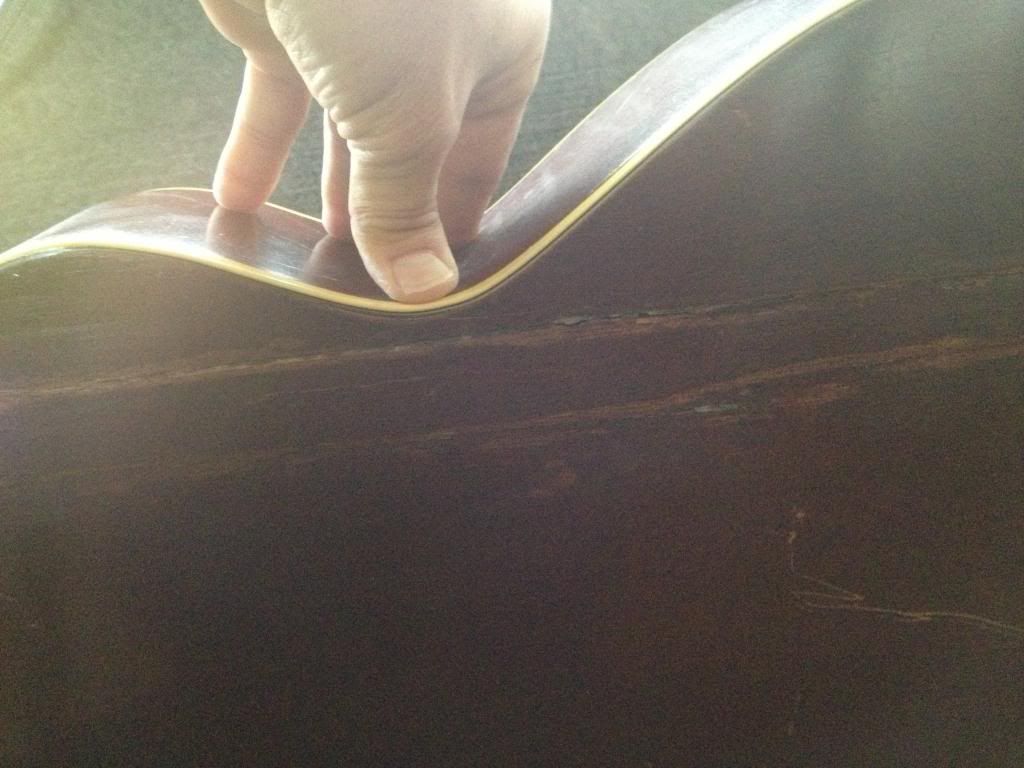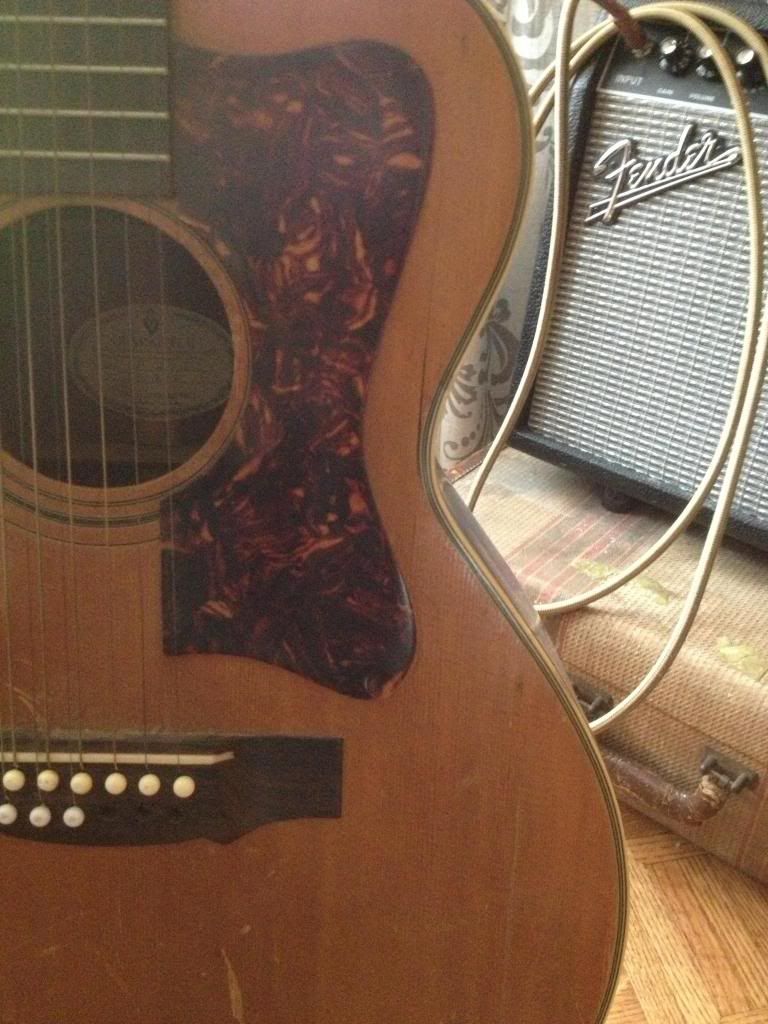
 |
|
#1
|
|||
|
|||
|
Repost from general discussion:
Help needed with old Guild 12 string repairs I am trying to make this old Guild F212 playable again. My experience is somewhat limited. I think it falls into the category of guitars that cost more to properly repair than it's value. So I'm going to work on it myself and I'm hoping to make it enjoyable to play for me. My assessment: (forgive me if my verbiage is not accurate) -All original but neglected & abused. -Multiple Cracks, 2 on the top that I would fill with CA glue. 3 on the back that have been repair and one has complete separated again. -Braces and Bridge intact. But the Bridge is somewhat bellying up. -Neck would most likely need to be reset...or could be the bridge is bellied up. Action is a little high at 12th fret, but I can live with that on a 12 string. A jld bridge doctor would probably help, but I don't have experience with them and would imagine they affect the tone. Few initial questions I have are: -Should I repair the large cracks by gluing and clamping with CA glue or use a wood glue that be better for future repairs? Reversible so to speak. -Would wooden cleats be needed? That would be a first for me to try. -Head stock plastic is just starting pealing up from the top. Just wood glue and clap? -I have been keeping it in a case with a few days with sponges, hoping to re-hydrate it. Does that make sense? Grateful for any advice. I haven't restrung it yet, waiting to repair the cracks first. But even the old rusted strings sound good...standard pitch. Thanks BB    
__________________
"Guitars For Vets", the healing power of music: https://www.facebook.com/pages/Guita...09965052625358 |
|
#2
|
|||
|
|||
|
The crack in the top is likely from the shrinkage of the celluloid pick guard. You should pull the pick guard before trying to repair that crack or you will just be fighting the pick guard to try and close it, it will likely close up a fair bit once the guard is off. CA should be avoided on these type repairs as it is a one shot deal, if it doesn't work you are where you are with little chance to do anything else. The back braces are definitely popped loose under one section of that big crack on the back. They will need re-glued as part of the repair if you expect it to last. Cleats will also be needed on that and perhaps the top as well.
|
|
#3
|
|||
|
|||
|
Thanks for the reply and information.
__________________
"Guitars For Vets", the healing power of music: https://www.facebook.com/pages/Guita...09965052625358 |
|
#4
|
|||
|
|||
|
Quote:
I recently repaired a couple guitars with similar issues. I prefer not to fill with CA glue whenever possible. On a crack like the one near the pickguard, I would hesitate based upon the photo alone to say that it is caused by pickguard shrinkage. The back was cracked in 3 places, one on the treble side relatively analagous to the position of the top crack. When back cracks are as substantial as the ones on your instrument, you have seen yourself the tendency for the sides near the waist to want to straighten and expand outwards. This pulling motion, combined with dryness possibly led to the top crack. Cracks that are as wide as the top crack are sometimes repaired with slivers in the violin and cello worlds, but occasionally with guitars as well. If you can fit a sliver in, that can be a good option. If a sliver won't fit in, making your own softwood fibre wood-paste with titebond can perform well. (Make some wood dust with a file and an off cut of spruce.) The present situation of the back is nearly to the point where you could consider removing the back, removing the bridge (if necessary) and bridgeplate, and re-gluing with a new bridge-plate to remove the bulk of the top warp. This would give greater opportunity to repair the back, and check fully the integrity of the top & re-glue braces if necessary. Guild's are generally built fairly robustly, so it could give you many more decades of playing pleasure if it was properly refreshed. Many (most?) Guilds are bound with plastic, so it isn't too difficult to rebind and scrape to size to match the present finish. If you do use a bridge doctor, it will reduce the tone coming from the instrument. I have never seen a situation that wasn't better served by replacing bridge-plate &/or bridge rather than doctoring it.
__________________
---- Ned Milburn NSDCC Master Artisan Dartmouth, Nova Scotia |
|
#5
|
|||
|
|||
|
Quote:
My plan is to get it in playing shape, use yellow wood glue to repair the cracks along with cleats, hoping not to do anything that would further damage it and could be worked on in the future. If I end up really enjoying this guitar and have the money, I can take it to someone like yourself to have it done properly...I wish you were close by. I've decided not to look at a bridge doctor, to me it has to change the tone from the sound board. It actually isn't really bellied that badly. We shall see when I restring it up. Thanks again I respect your opinion. I'll repost my progress if interested.
__________________
"Guitars For Vets", the healing power of music: https://www.facebook.com/pages/Guita...09965052625358 |